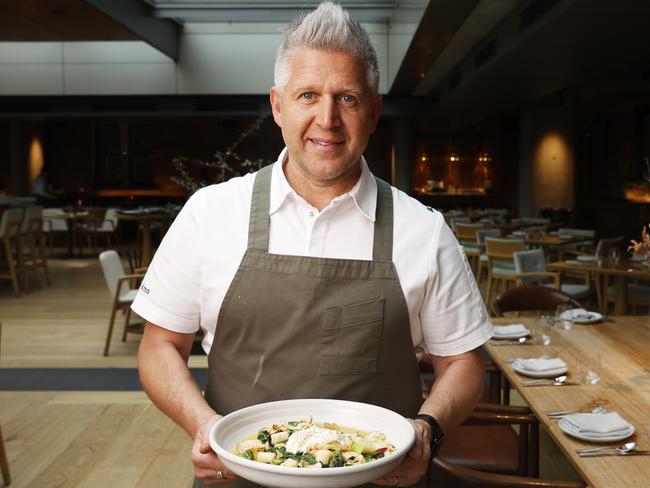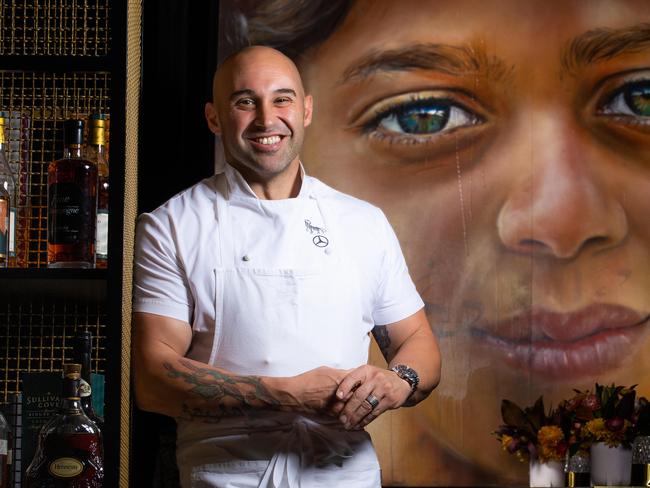The real reason restaurants are closing in Melbourne
The biggest names in food are uniting in a crisis meeting to work out how to save more restaurants from closing as further dark days loom for the hospitality industry.
Food
Don't miss out on the headlines from Food. Followed categories will be added to My News.
Desperate restaurants will be forced to take prime cuts off the menu, shut on public holidays and charge $50 for counter meals just to stay afloat, as the hospitality industry battles through its darkest days yet.
Top chefs and long-time restaurateurs have also revealed they’re only making 60c from a $30 plate of food – but are at odds about raising prices out of fear cash-strapped diners will stop eating out.
It comes as some of Australia’s biggest names in food and hospitality will on Friday hold a crisis meeting in a bid to save their industry from crippling financial pressures which has already shuttered hundreds of venues.
The Herald Sun understands top-name chefs, restaurateurs and industry leaders are joining forces with a plan to lobby all levels of government, asking for tax concessions and diner incentives, such as the voucher schemes seen post-Covid.

More than ten Melbourne restaurants have closed in 60 days, several in Sydney, with many on a knife edge and more big names expected to shut over winter.
One in every 13 hospitality businesses faces failure within the next 12 months, says a grim CreditorWatch report released last week.
La Luna, Izakaya Den, Gingerboy, Botswana Butchery, Om Nom and Rosetta are among the recent casualties.
CBD restaurateur Con Christopoulos, behind The European and Butcher’s Diner, said the industry was going through significant changes well before Covid.
“Gone are the days where you can give good food or good service at a price,” he said.
“Now you have to choose one or the other.”
“At Butcher’s Diner, we have an affordable and high quality product – but there’s no service. Here, I can reduce my wage cost by 10 per cent, but I can’t reduce food costs. Or you could go to places like Gimlet. Sure it’ll be expensive, you’ll pay $60 for fish, but that’s the way it is.
“You get great service – but you’ve got to pay for it.”
Mr Christopoulos said employee costs were the biggest financial burden on restaurants, and while he stands for paying his staff what they’re entitled, penalty rates have made him reconsider opening on public holidays.
“Our industry should never open on a public holiday. Those (venues) that are opening and paying wages aren’t making money,” he said.
“If we opened on public holidays it’ll take us another two weeks to get back to where we were.”
Publican Liam Matthews is also feeling the pinch. Abbotsford’s Carringbush Hotel will pour its last beer on Saturday, due to soaring expenses.

To make any serious profit margin, Mr Matthews said he would have to charge $10 for a pot or $50 for a counter meal.
“Nobody is ready for that. We had to raise it to $30 and people are suffering with that,” he said.
Celebrated Tasmanian chef Massimo Mele, who has worked in kitchens for three decades, said he didn’t feel in control any more.
The TV chef is now considering whole butchery to make the most of an animal – or get rid of prime cuts altogether over winter.
“I now have to think of whole butchery, buy a whole cow and try and make the most of different cuts … or stop serving high-end prime cuts to get through winter,” Mele said.
“Rib-eye costs $150/kg – and that’s cost price. I don’t think I can serve customers a $500 steak.”
Mr Mele is culinary director at Launceston’s Grain of Silos and Italian restaurant Peppina at Hobart’s The Tasman hotel – and he’s in the kitchen five days a week to help his staff weather the storm.
“I’m in there because I don’t want my staff to do overtime. They get exhausted and there is no one else to do it,” he said.
“You end up doing a lot yourself. I am really exhausted by always thinking ‘what will I have to do to make it work?’ and worry the restaurant won’t be here in 12 months.”

‘I know what it’s like to not have money’
Long-time Melbourne restaurateur Caterina Borsato has struck a bout of bad luck.
A burst water main and flooding forced the closure of her Italian restaurant, Caterina’s Cucina E Bar, of almost 30 years indefinitely last fortnight.
“If I did not have insurance, I’d be screwed,” she said.
“The only reason I am calm is I know money is not going to be the issue at the moment.
“I’m a very conservative businesswoman, I know what it’s like to not have money.
“When I started this business I had no money. You have to have a certain amount of money in the bank to be operational.”
“But if you stay out (of the game) long enough, it’ll damage you one way or another.”
Ms Borsato said the days of running a business by the 30/30/30 rule were long gone.
“That’s 30 per cent of spending went to goods, 30 per cent to running costs and 30 per cent to wages. Then you’d have 10 per cent left over, in the good old days, maybe 15-20 per cent profit if you are a cafe,” she said. “Now, restaurants have dropped to 6-7-8 per cent profit. More businesses are sitting at 5-8 per cent, is what I’m hearing.”
TV chef Shane Delia said it wasn’t just the lack of restaurant earnings causing financial strain.
“I spent $2000 on getting new plates. We had the florists come in today, our freezer broke and that’s cost $6500. The guy who curates the incense in our restaurant cost $140 – and this is all incurred before I open the door … and your lunch still costs $45,” he said.

Delia understands that this is just the way of the industry and said he was “never the guy that whinges”. He knows times are tough and things will get better soon.
“The industry has always been challenged, it’s going through a challenging part, and another five years time, we’ll have another. That’s the industry we are in – and I like that it’s not easy, that it’s hard.
“There are restaurants that aren’t up for the fight, due to whatever reasons, and that’s heartbreaking. The mum and pop businesses, with that as their only income … I get we aren’t bulletproof.”
Delia said restaurants needed government support to stay afloat.
“The only thing that’ll save restaurants is restaurants. Restaurants need to be united. We can’t be fragmented. We are the largest industry in this country and we aren’t represented properly,” he said.
“We need to be represented at all government levels. That’s how change will be made.”
Mr Christopolous agreed good times were around the corner.
“Absolutely. Life is all cyclical.
“You feel for those that have lost businesses — it’s a killer But as one door closes, another opens. It’s the way of the world.”




